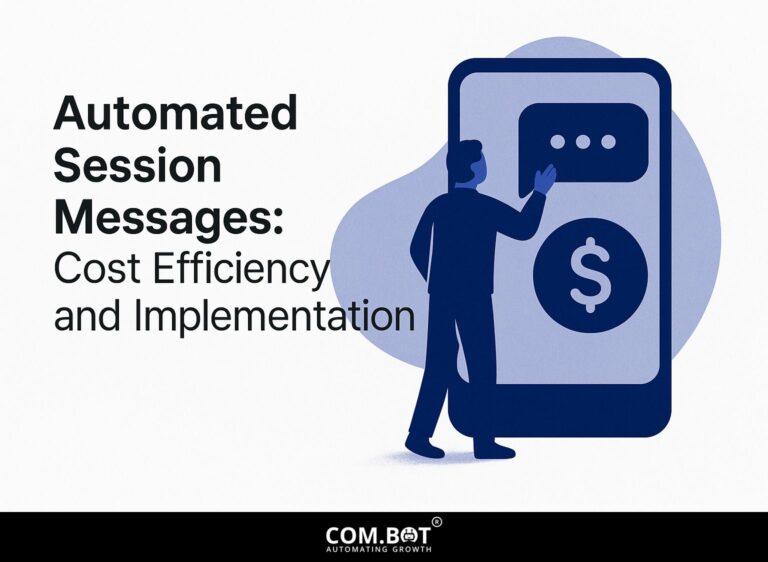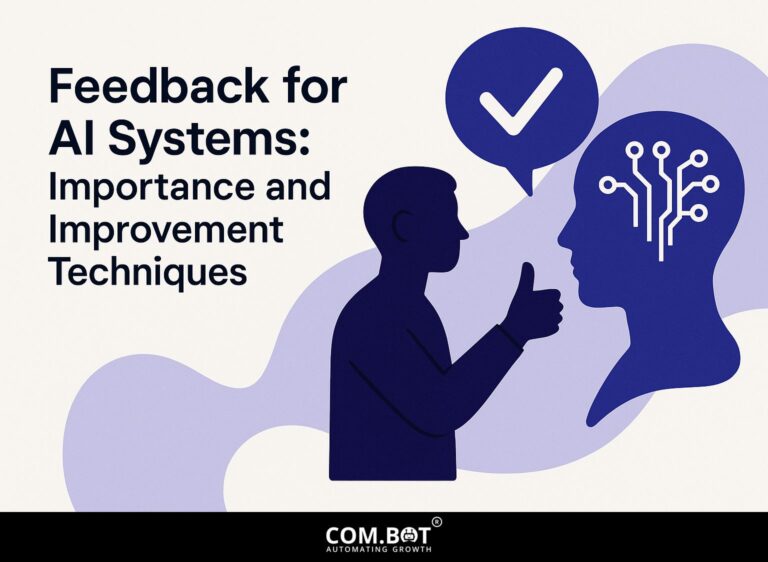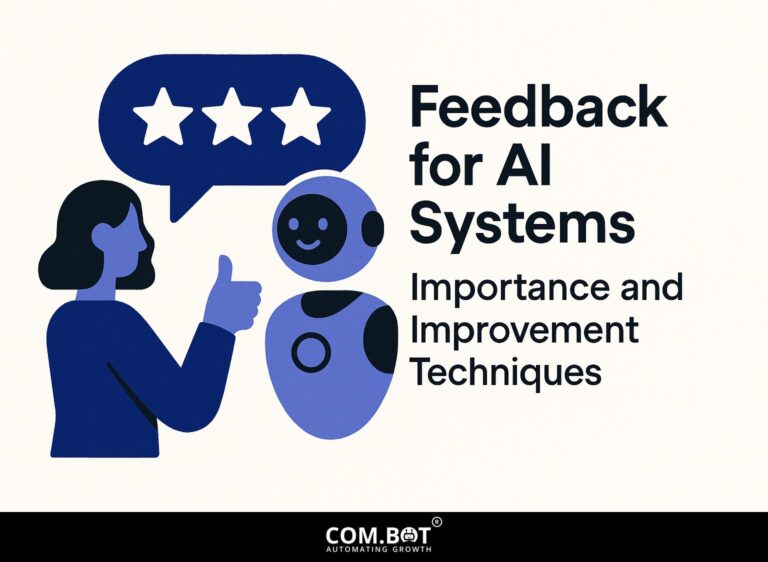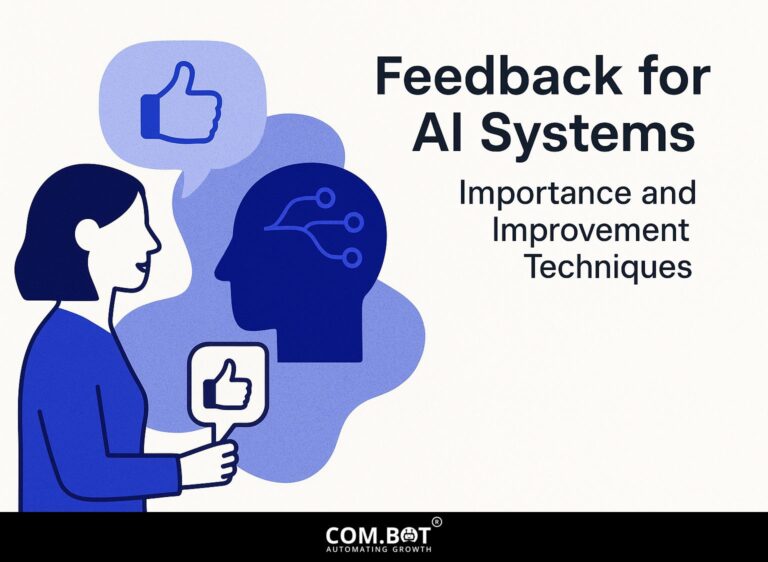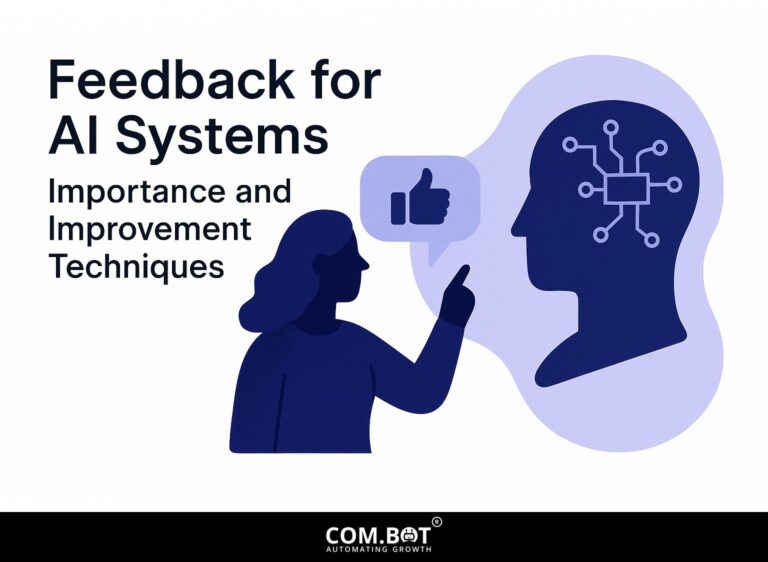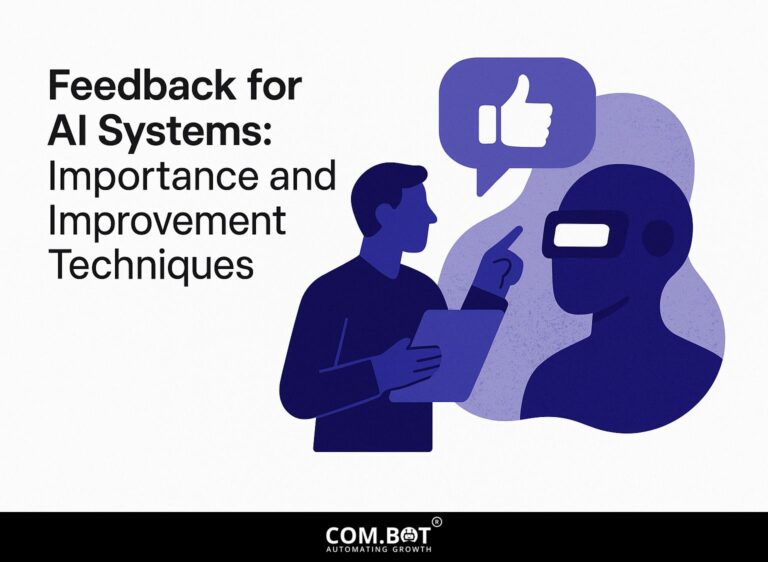Feedback for AI Systems: Importance and Improvement Techniques
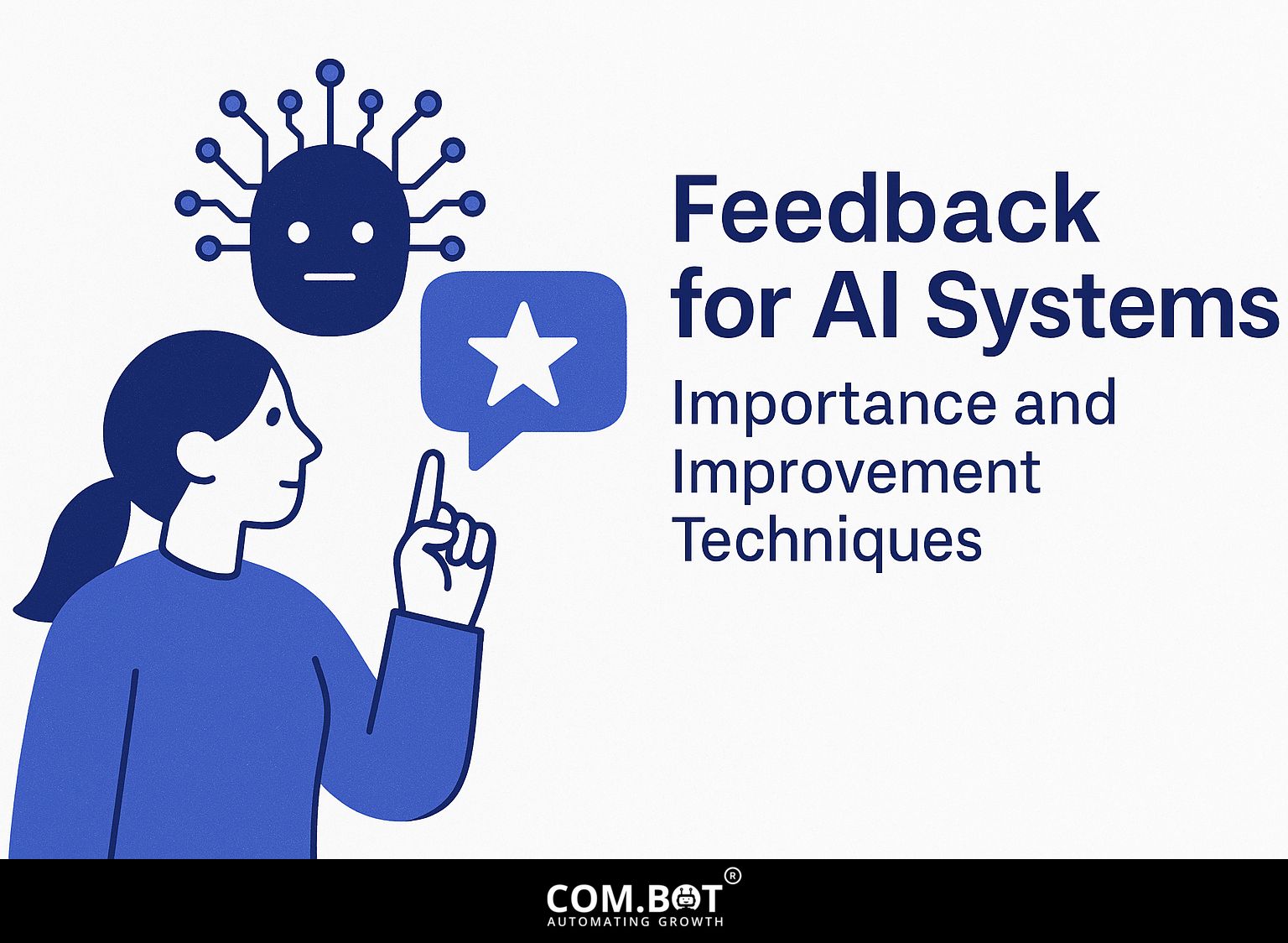
As artificial intelligence (AI) improves, feedback for AI systems becomes increasingly important. Organizations depend on watching systems closely to improve performance and adjust algorithms. This article discusses the importance of feedback in AI development, providing useful methods to make systems more accurate and tackle ethical issues. Learn how to use feedback to create intelligent AI systems that can succeed in a fast-changing environment.
Key Takeaways:
- 1 Importance of Feedback for AI Systems
- 2 Types of Feedback Mechanisms
- 3 AI Feedback Mechanisms Statistics
- 3.1 Bias Amplification in Human-AI Interaction: Human AI Interaction Bias
- 3.2 Bias Amplification in Human-AI Interaction: Algorithm-induced Bias Amplification
- 3.3 Bias Amplification in Human-AI Interaction: AI Feedback Loops in Customer Feedback Management
- 3.4 Human-in-the-Loop Approaches
- 3.5 Automated Feedback Systems
- 4 Techniques for Gathering Feedback
- 5 Implementing Feedback for Improvement
- 6 Challenges in Feedback Implementation
- 7 Frequently Asked Questions
- 7.1 Why is feedback important for AI systems?
- 7.2 What are the benefits of providing feedback to AI systems?
- 7.3 How can feedback be collected for AI systems?
- 7.4 What are some techniques for improving AI systems based on feedback?
- 7.5 How can feedback be used to monitor and detect biases in AI systems?
- 7.6 What role does human involvement play in providing feedback for AI systems?
Definition of Feedback in AI
Feedback in AI means looking at the results of algorithms to help make better decisions and improve machine learning models.
To improve model accuracy, use techniques like reinforcement learning, where systems learn from user interactions and make changes based on that feedback.
Netflix examines what viewers like to suggest shows, customizing later recommendations.
Similarly, chatbots like Drift adjust responses based on user interactions, identifying which phrases lead to more engagement.
Including these feedback systems improves user experience and increases retention rates because models change to provide more relevant content based on recent data.
Role of Feedback in AI Development
In AI development, feedback systems are essential for fine-tuning algorithms and improving prediction accuracy, leading to the progress of intelligent technologies.
A clear example is self-driving cars, which use live data from sensors to keep enhancing their working algorithms.
For example, Tesla gathers a lot of data from its cars to improve its Autopilot system. When a vehicle faces an unusual obstacle, that experience is recorded and studied, so the main algorithm can change how it reacts next time.
Simulation tools let developers see how changes impact various situations, ensuring the system stays strong as it expands.
Importance of Feedback for AI Systems
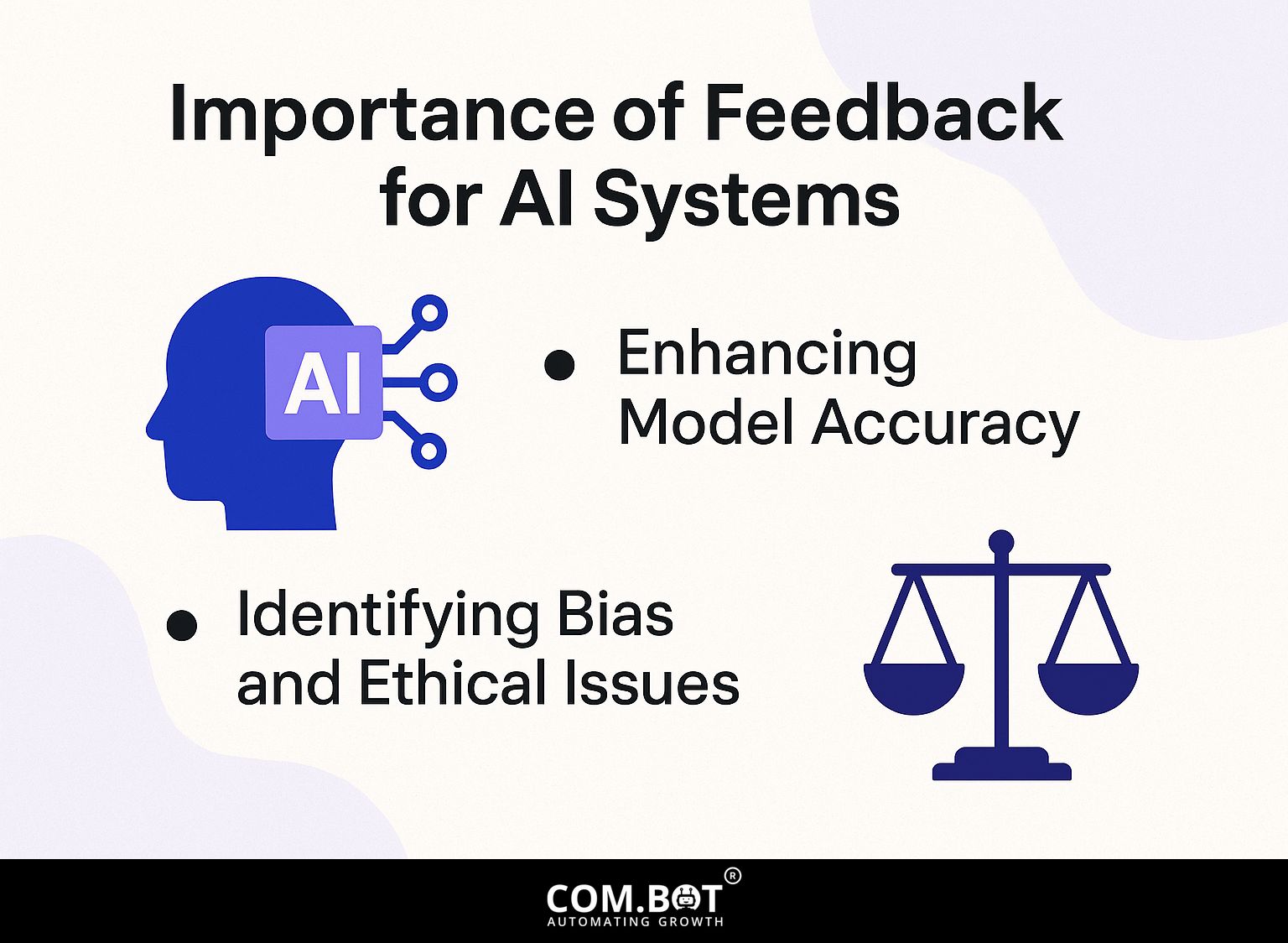
Including feedback in AI systems is essential for improving model accuracy and dealing with ethical issues that come up when they are used. For those interested in understanding the importance and techniques for enhancing AI systems, our detailed article on Feedback for AI Systems provides further insights.
Enhancing Model Accuracy
Using feedback repeatedly can improve the accuracy of models by up to 30% in machine learning tasks.
For example, a healthcare app can collect patient opinions after tests, using tools like SurveyMonkey or Google Forms to collect thoughts on how clear and correct the information is.
This data is then analyzed to identify patterns, which can lead to adjustments in the diagnostic algorithms. By updating these models with actual user inputs, the app improves its ability to predict outcomes and gains trust from users who see their feedback leading to better performance.
Continuous iterations based on user experience are critical for long-term success.
Identifying Bias and Ethical Issues
Feedback helps make algorithms better and is important for identifying biases, which is key for using AI in a fair way.
A good way to spot bias is to routinely check AI results by looking at user feedback for differences. For instance, Amazon’s AI hiring tool initially favored male candidates, but after user feedback highlighted gender bias, the company updated its algorithms.
This process set up a planned feedback system, gathering input from different users, which helped lower bias. Incorporating tools like Fairness Indicators can also help monitor model performance across different demographic groups, ensuring a more equitable approach in machine learning outcomes.
Types of Feedback Mechanisms
There are various ways to get feedback that make user interactions better and improve AI systems, either through human input or computer-driven methods. For more insights, you can explore our detailed guide on the importance and improvement techniques of feedback for AI systems.
AI Feedback Mechanisms Statistics
AI Feedback Mechanisms Statistics
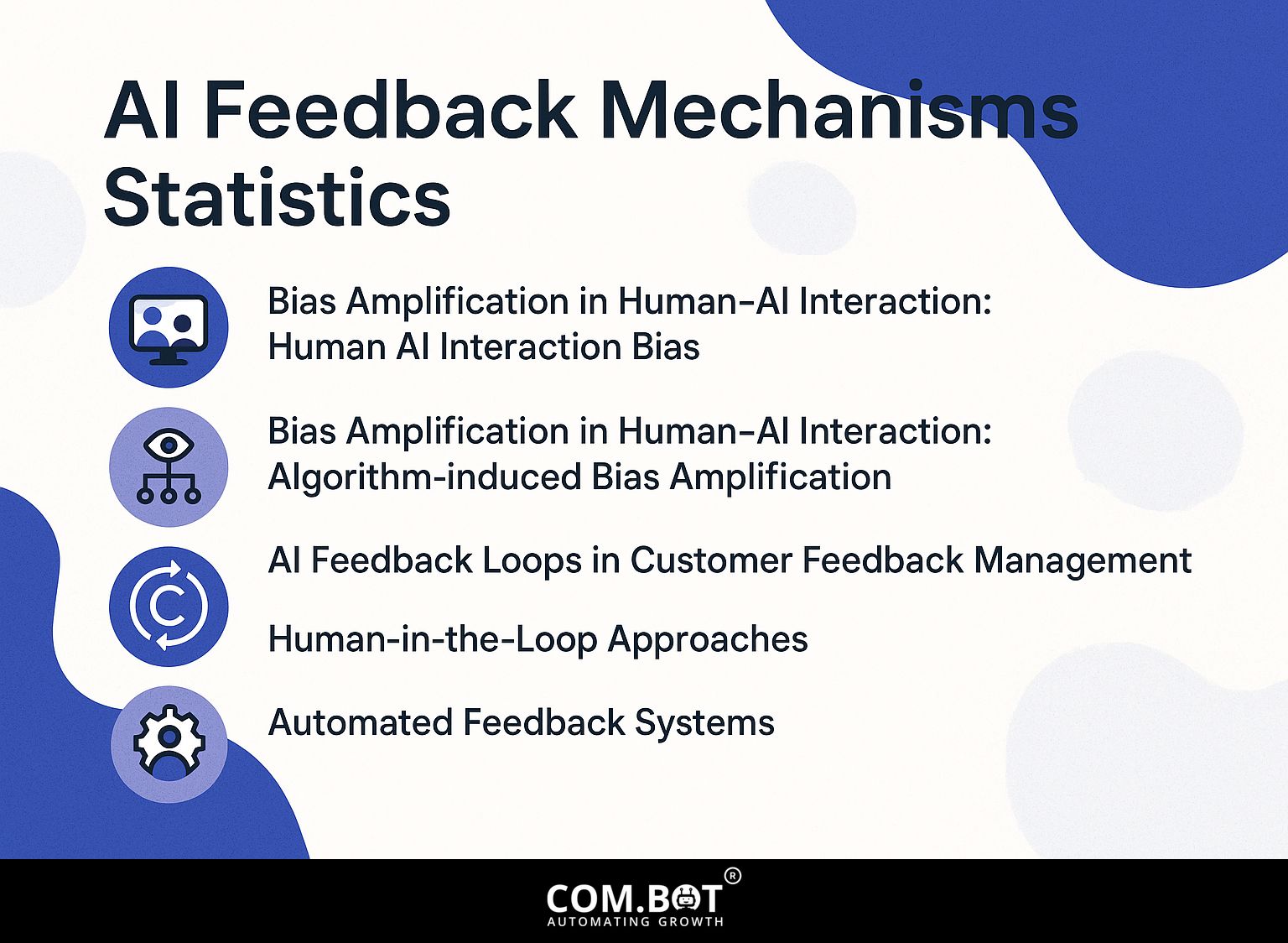
Bias Amplification in Human-AI Interaction: Human AI Interaction Bias
Bias Amplification in Human-AI Interaction: Algorithm-induced Bias Amplification
Bias Amplification in Human-AI Interaction: AI Feedback Loops in Customer Feedback Management
The AI Feedback Mechanisms Statistics offers important information on how AI systems affect human interactions, especially regarding the increase of bias and repetitive patterns. This information shows the challenges and possible problems of depending on AI for making decisions, especially when these systems are based on human input.
Bias Amplification in Human-AI Interaction reveals a concerning trend: AI can exacerbate existing human biases. Initially, the baseline human bias for “Sad Responses” stands at 49.9%, but after interaction with AI, this bias increases to 56.3%, resulting in a 7.3% increase. This shows that AI could increase bias if not handled properly.
- Algorithm-induced Bias Amplification: The data shows an initial human bias of 53.08% for sad responses. However, after AI systems learn from this data, their tendency to show bias becomes much greater. 65.33%. This means AI can accidentally learn and repeat the biases present in the training data. It’s important to make algorithms that can find and fix these biases.
AI Feedback Loops in Customer Feedback Management also show significant impact. AI systems can detect a 32.72% change in customer sentiment and decisions, compared to only a 3.97% change without AI intervention. This highlights AI’s ability to influence customer decisions significantly, both positively and negatively.
These statistics highlight that AI can both increase biases and affect decisions. Although AI systems can make processes more efficient and improve decision-making, they also run the risk of continuing and increasing existing biases. Therefore, it’s important to include ways to find and reduce bias when creating AI systems to make sure results are fair and effective.
Human-in-the-Loop Approaches
Human-in-the-loop approaches involve real user interactions that provide qualitative feedback, essential for refining AI models in complex environments.
For example, an AI customer service chatbot can greatly improve its responses by analyzing live chat interactions. The process starts with the bot handling queries where human agents monitor specific conversations.
Afterward, these agents provide feedback on the bot’s performance, highlighting areas for improvement. This feedback loop helps the AI adjust its algorithms, increasing accuracy over time.
Tools like Dialogflow help with this integration, enabling developers to train their bots using actual data while focusing on human knowledge as a key part of the learning process.
Automated Feedback Systems
Automated feedback systems continuously monitor performance data and use algorithms to adjust AI actions on their own, without human intervention.
For example, a fraud detection system might analyze transaction data in real-time. It uses machine learning algorithms that learn by identifying patterns in real and fake transactions.
When an anomaly is detected, the system triggers alerts and automatically adjusts thresholds for risk assessments. As these systems learn, they become better at identifying issues, leading to fewer errors and better detection rates. This improvement can help banks save millions.
Tools like TensorFlow or AWS SageMaker can help create and change these models, enabling organizations to set up automated monitoring quickly.
Techniques for Gathering Feedback
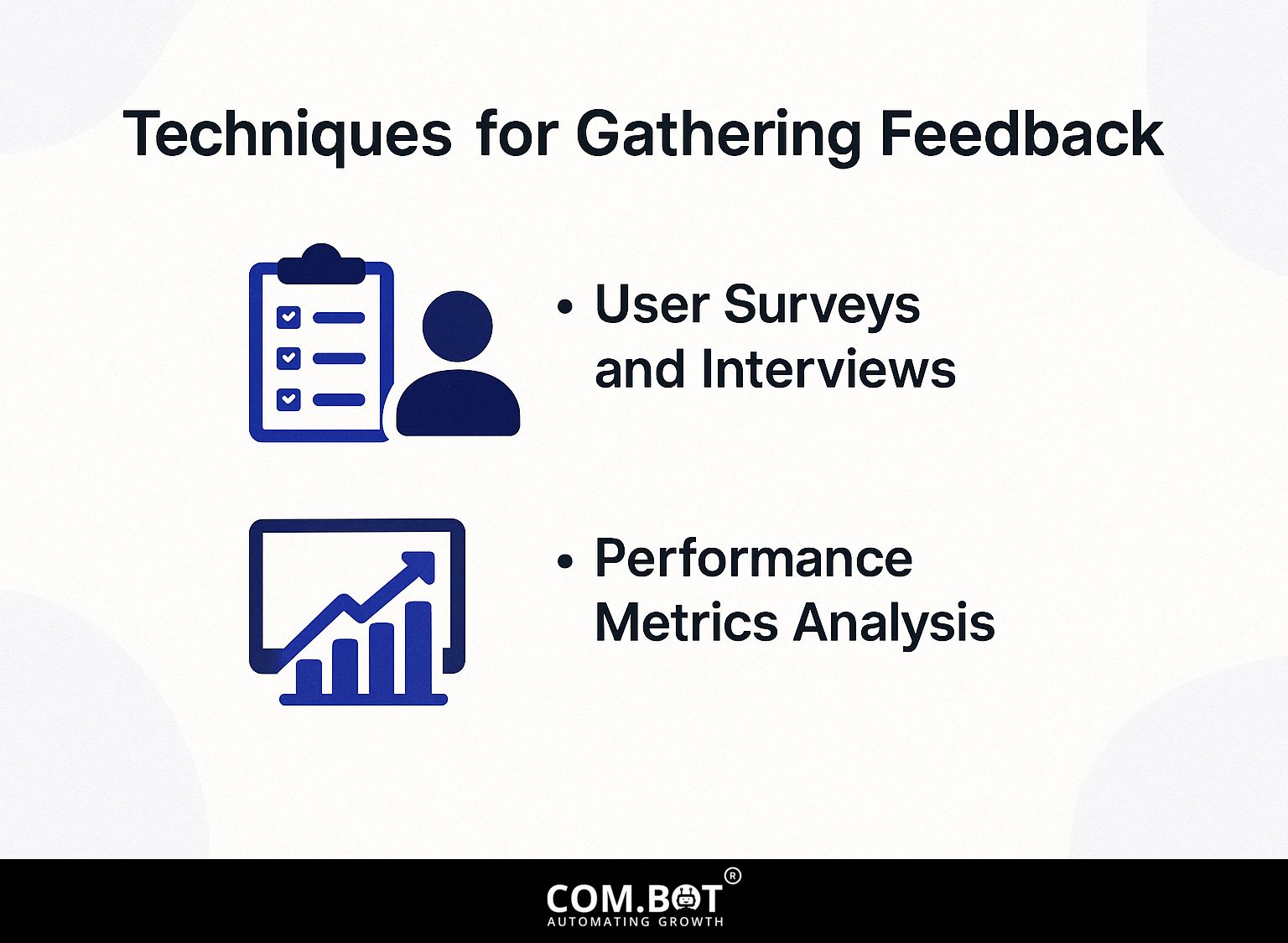
Collecting useful feedback takes various methods, allowing businesses to improve AI models with actual user input and obvious results. To truly understand how businesses can enhance their AI systems through feedback, it’s essential to explore different importance and improvement techniques that have proven successful.
User Surveys and Interviews
User surveys provide detailed feedback, showing user experiences and preferences that are important for improving AI systems.
To create effective user surveys, choose tools that make it easy to gather information. For example, SurveyMonkey (starting at $25/month) provides features such as branching logic to improve user experience. Alternatively, Google Forms is a great free option for simpler needs.
Use open-ended questions to get more detailed answers; these let people express their thoughts and feelings. For example, asking “What features do you find most useful?” can yield more actionable feedback than yes/no questions.
Use different kinds of questions to keep people interested and get complete information.
Performance Metrics Analysis
Reviewing performance measurements like accuracy and user satisfaction scores gives useful numerical feedback essential for improving AI.
To set up a strong system for analyzing performance metrics, start by selecting your visualization tool. For example, Tableau offers advanced data visualization capabilities at $70 per month, which is excellent for detailed analysis. Alternatively, Google Data Studio is a free option that provides customizable reports.
- Start by defining key metrics like accuracy rates and user feedback scores.
- Connect your data source, whether it’s a database or spreadsheet, and create charts or dashboards.
Looking at these visualizations each week can give you helpful details to make your AI models better.
Implementing Feedback for Improvement
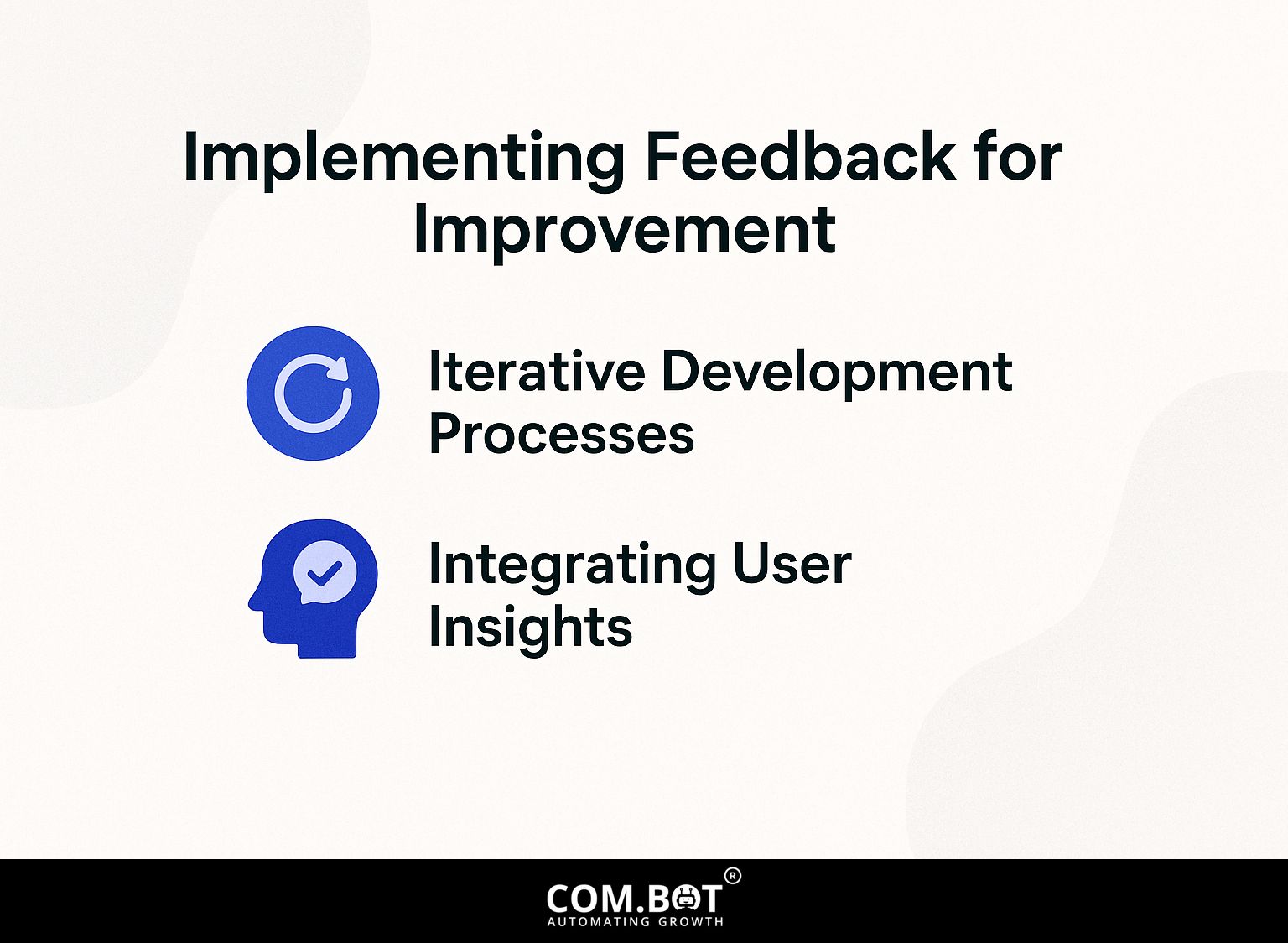
To apply feedback effectively, use organized methods that repeatedly improve AI designs and include user feedback in the development process. For an extensive analysis of this approach, our comprehensive study on feedback for AI systems examines various techniques and their importance.
Iterative Development Processes
Agile development steps allow teams to promptly adjust their work based on feedback, improving AI systems as a whole.
The Agile method includes important steps: planning, doing the work, and looking back at what was done.
During planning, tech companies like Google define their project goals and identify necessary resources.
In the execution phase, teams implement features in sprints, using tools like Jira to track progress and manage tasks.
The review stage includes retrospectives where teams assess what worked well and what needs improvement. Spotify uses this method to improve their AI music suggestions by regularly updating algorithms with user feedback.
This process encourages change, resulting in better AI systems.
Integrating User Insights
Including what users want and expect in the development process makes sure AI systems match what users need.
To effectively use user feedback, begin by using Trello to organize tasks. Create a board dedicated to feedback collection, where team members can input suggestions from users.
Next, organize these findings by how often they occur and how much they could affect things, sorting them into tasks you can act on. Establish a regular review process, such as bi-weekly meetings, to assess the implementation of these feedback-driven tasks.
Think about using tools like UserTesting to collect feedback from users, which lets you involve them directly in improving your product.
Challenges in Feedback Implementation
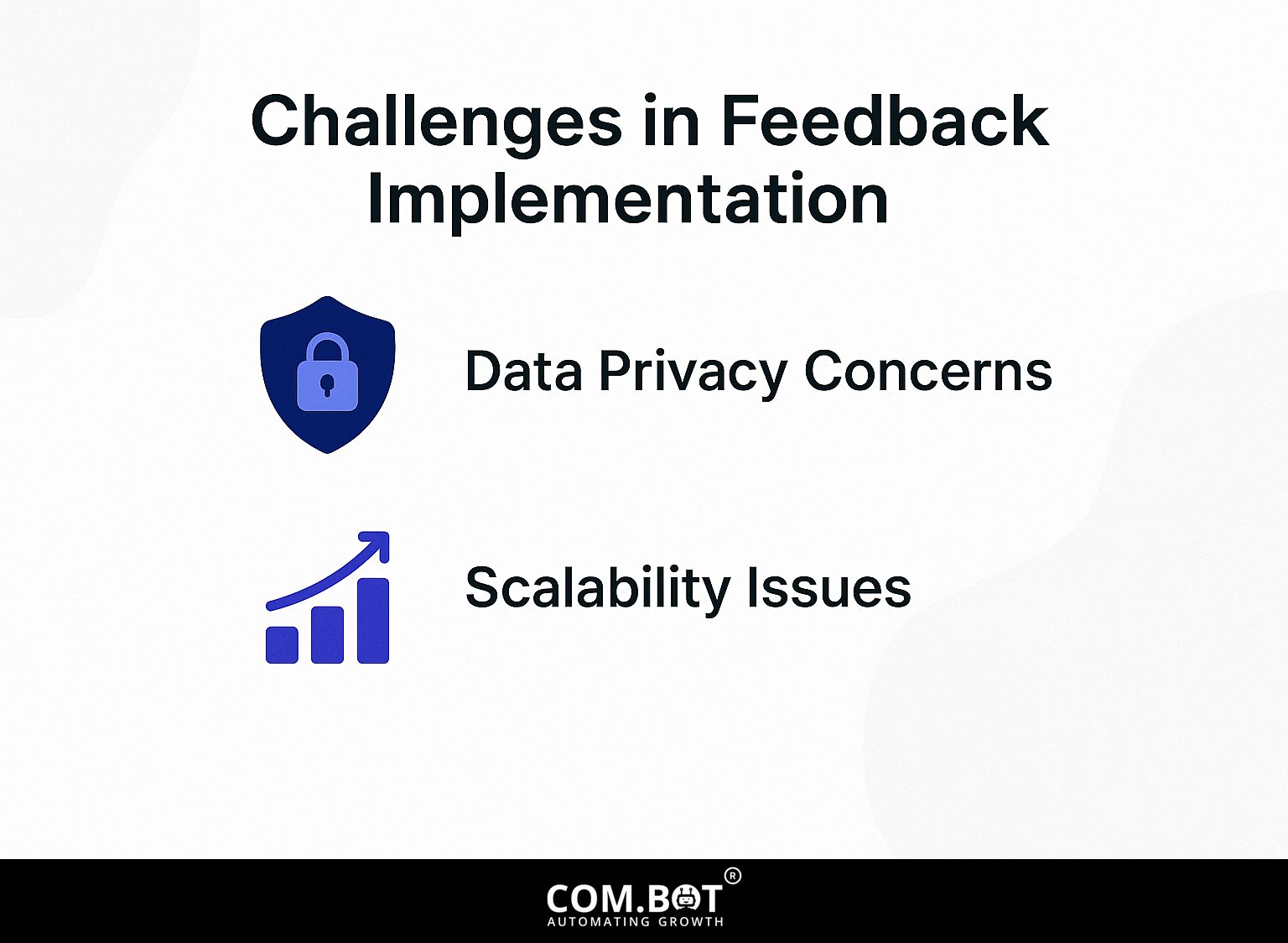
While feedback is important, organizations have challenges that need to be addressed to use feedback in AI systems successfully. A hidden gem in addressing these issues can be found in our exploration of Feedback for AI Systems: Importance and Improvement Techniques, which offers strategies to enhance feedback utilization.
Data Privacy Concerns
It’s important to keep user information safe when using feedback systems, so we need strong ways to protect the data.
To address these concerns, organizations should implement data anonymization techniques, such as removing personally identifiable information (PII) from feedback forms.
Following GDPR rules is essential; you must get clear permission from users before you gather their data. Using tools like OneTrust for compliance can make it easier to update and apply policies.
Regular checks are important for finding possible weaknesses, allowing teams to keep improving their security measures.
By focusing on these strategies, companies can build user trust and gather helpful feedback.
Scalability Issues
As organizations scale their AI systems, feedback mechanisms can face challenges in maintaining efficacy and relevance across diverse user bases.
To address these challenges, consider implementing a tiered feedback approach.
Begin by sorting comments based on different user categories, ensuring you collect details from every audience type.
Second, use tools like SurveyMonkey or Typeform to collect feedback regularly, which makes it easier to assess.
Use feedback to improve your AI model updates by utilizing machine learning tools like TensorFlow or PyTorch. These tools can help improve algorithms using actual data.
Regularly checking and changing these methods is essential to stay current.
Frequently Asked Questions
Why is feedback important for AI systems?
Feedback is important for AI systems because it helps them keep learning and get better at what they do. Without feedback, these systems would not be able to fix mistakes, predict accurately, or work better.
What are the benefits of providing feedback to AI systems?
Providing feedback to AI systems helps them find and fix errors, make better choices, and perform tasks more accurately and quickly. Feedback can reveal new patterns and knowledge that can make the system perform better.
How can feedback be collected for AI systems?
Feedback for AI systems can be collected through various methods, such as surveys, user ratings, comments, and data analysis. These methods can give useful details about how well the system works, where it can get better, and how happy users are.
What are some techniques for improving AI systems based on feedback?
One way to improve is to use machine learning methods that take feedback data to keep improving the system’s performance. Another method is to consistently update and train the system with the latest data and answers to make it more accurate and faster.
How can feedback be used to monitor and detect biases in AI systems?
Feedback can be used to monitor AI systems for any biased or discriminatory patterns that may have been learned from the feedback data. By finding and correcting these biases, we can make sure that AI systems make fair and impartial decisions.
What role does human involvement play in providing feedback for AI systems?
People need to be involved to give helpful and correct feedback for AI systems. People’s feedback and evaluation can help the system handle and grasp complex information, resulting in better decisions and improved performance.
